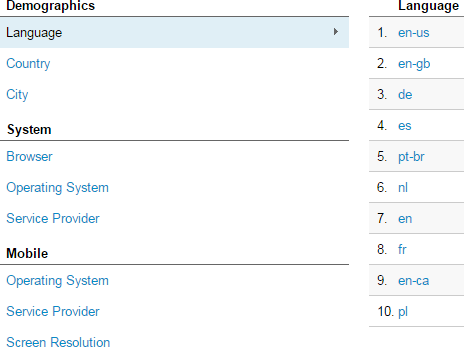How to Understand Unique Visitors in Google Analytics

Unique visitors in Google Analytics, also known as “Users”, is an invaluable tool for measuring, tracking and understanding a site’s audience.
The official Google Analytics definition of this Web metric was: “Unique Visitors is the number of unduplicated (counted only once) visitors to your website over the course of a specified time period.”
The new “user” definition is: “Users that have had at least one session within the selected date range. Includes both new and returning users.”
Tracking this number at least monthly is an industry standard for understanding if a site’s audience is increasing, decreasing or staying even.
How to Find the Unique Visitors
In Analytics, click on Audience in the top left of the page and then on Overview.
The graph at the top will show users / unique visitors over the last 30 days. Another imortant metric there is “sessions”, formerly known as visits. It is the number of times a user or unique visitor comes to a site.
For example, if the site has 10,000 users and 20,000 sessions, it means that on average the users visited the site twice a month.
The user / unique visitor number is found below the graph in the list between Sessions (which used to be called Visits) and Page Views.
Right below the Overview tab, click on Sessions to see its graph appear at the top of the page in place of the Visits graph.
What the Number Really Means
Google used to display Sessions first. I have often thought that Google did so because it thinks visits are more important than unique visitors.
One possible reason is that the unique visitor number is not always what it appears to be. The number is calculated by using browser cookies and other means.
“Google Analytics uses cookies to define user sessions, as well as to provide a number of key features in the Google Analytics reports. Google Analytics sets or updates cookies only to collect data required for the reports. Additionally, Google Analytics uses first-party cookies,” Google says on its developer site.
The use of cookies will matter to the final results quite a bit for some of the following reasons:
- A single person can use a computer at work and then at home. He or she will be counted as two unique visitors via cookies but be only one person.
- A family of four people can all use the same computer. The computer will be counted as one unique visitor when in fact four people are using it.
- Someone manually clears their cookies. They may be treated as two unique visitors because of two sets of cookies.
It is not surprising that Google used to place more importance on visits than unique visitors. It still remains an important number and more accurate than the unique visitor number.
That said, the unique visitor number is an industry metric and does provide a useful way of tracking site audience.
Just use it carefully, work to increase the total and understand its limitations. It is best to track it in combination with sessions / visits and page views.
Daily, Weekly and Monthly Tips
Analytics software such as Google Analytics can slice and dice unique visitors for just about any time period. The most common periods are daily, weekly and monthly.
Beginners will sometimes take a daily number and multiply it by 30 to predict a monthly number. Unfortunately, that formula doesn’t work because of repeat visits by the same unique visitors.
If I visit a website today, I am one unique visitor. If I come back tomorrow, I am still one unique visitor for the month and not two.
The concept of the repeat visitor is another reason to value visits / sessions more than the unique visitor / user number.
A monthly view is best in comparison with the previous month and the same month of the prior year. Comparing the most recent month with the same month of the prior year is an useful way to measure growth or decline in audience.
Demographics, System, Mobile and Language

The bottom of the Analytics user report offers links to Demographics, System, Mobile and Language reports.
This section lies underneath the graphical report and numbers that dominate the top of the report.
Note that clicking on some of these reports will display numbers for sessions / visits instead of users / unique visitors.
Sites with a local audience will find the ability to drill down to individual cities, while anyone with an international audience can drill down by country. The language report provides similar results.
The same information is available under Audience / Geo / Location report.
The system reports may be the least used, while the mobile report has useful information about the screen resolution that aids in a mobile-friendly site design.
Mobile Versus Desktop
The rapid rise of mobile means it is becoming important for analysts to track the split between mobile and desktop users. Google Analytics makes that possible with the above report, but it offers other options for analysis.
Look above the graphic at the top of the main audience report page and to the right for something that says + Add Segment. Click on it and select Mobile Traffic (or any other category that looks interesting) and then click on Apply.
The resulting graphic and numbers underneath will show mobile traffic as a proportion of the total traffic. The breakout includes not only users but also sessions and page views.
Sites with a commitment to mobile will want to use this report to track progress in growing total mobile audience, which should outpace desktop growth over time.
Other Insights From Unique Visitors
Clients who look at the unique visitor numbers in analytic reports often compare the current month with the previous one to see if the numbers go up or down.
Month over month comparisons are often misleading because many factors go into the final results for a month. They include:
- Holidays
- School schedules
- Distracting news events
- Severe weather
- Promotional budgets
Although month over month changes are worth watching, an even better insight comes from year over year because that comparison compensates for some of the above factors.
The rate of growth for each year-over-year comparison provides a trend line that also reveals the success or failure in growing audience.
Finally, the YOY breakdown by segment — geography, technology or demographics — also is important in targeting the growth of valuable niches and letting less valuable niches languish or decline.



 Promise Media offers online business tips and best practices for content-rich websites.
Promise Media offers online business tips and best practices for content-rich websites.
April 4th, 2019 at 12:32 pm
Is there a way to get total unique visitors and total page views for all URLs of a site that start with the same xyz? i.e. for this site pull those #s for all activity under the “Marketing” heading.
April 5th, 2019 at 8:40 am
Hi, Janet. If I understand your question correctly, I can do a search in Google Analytics in the Behavior / Site Content / All Pages section to get total page views for a set of URLs on a site that have a common word in the URL such as “marketing”. The search box is below the graph and toward the right.
On that same report, I can get the number of visits under the Entrances column heading that arrived on those pages from a source outside of the site. Entrances is really a visits / sessions number and not a users / unique visitors number, but they two are usually very close to each other.
October 9th, 2019 at 8:13 am
How we can Find daily unique visitors?
October 15th, 2019 at 1:40 pm
Please go to Audience / Overview. The “Users” number is the same as unique visitors. On the graphic, hover over the day. It will pop up the users / unique visitors for that day.
October 12th, 2020 at 12:26 am
I have not thought like that that finding a unique visitor contains that much. Which is behind the PC. You point is also correct.